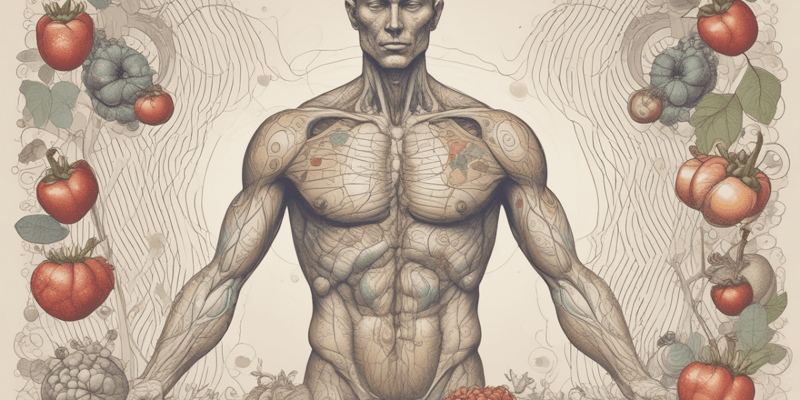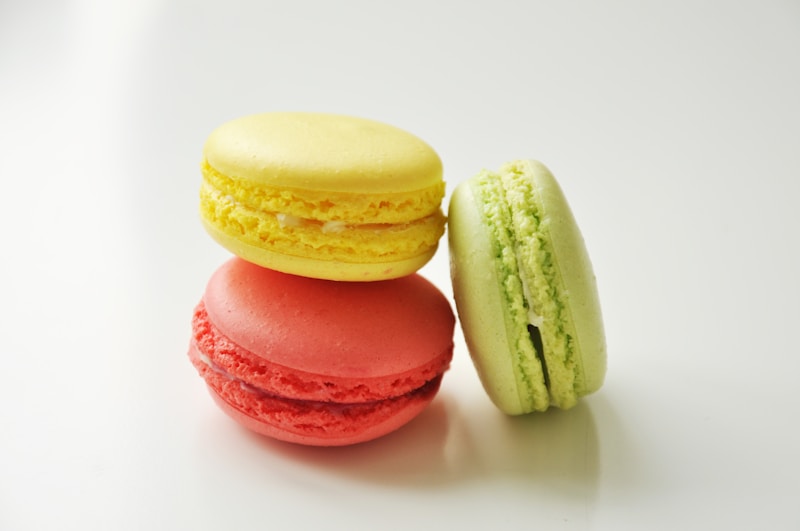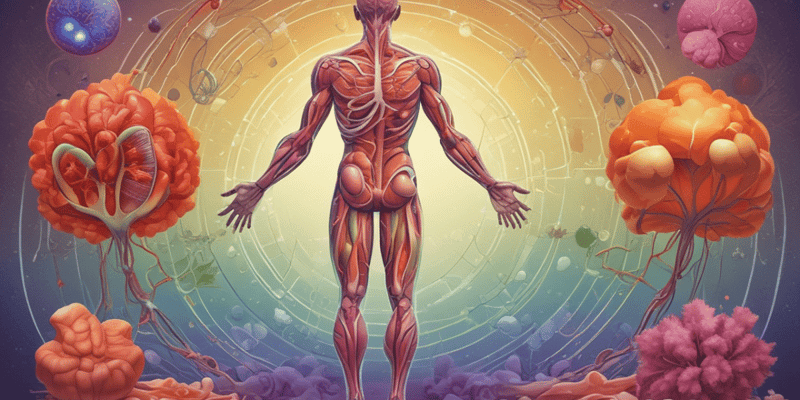Questions and Answers
Which of the following fat-soluble vitamins is NOT stored in the body?
Vitamin K
What is the primary source of energy for neurons and RBCs?
Glucose
What is the primary function of anabolism in cellular metabolism?
Synthesis of large molecules from small ones
What is the primary function of prostaglandins in the body?
Signup and view all the answers
Glucose is catabolized through which three pathways?
Signup and view all the answers
What is the term for the breakdown of glycogen to glucose?
Signup and view all the answers
What is the primary function of minerals in the body?
Signup and view all the answers
What is the term for the process by which glucose is converted to glycogen for storage?
Signup and view all the answers
What is the end result of the complete breakdown of glucose in cellular respiration?
Signup and view all the answers
What is the term for the measurement of the body's energy expenditure at rest?
Signup and view all the answers
What is the net gain of ATP in the process of glycolysis?
Signup and view all the answers
Which of the following is NOT a type of lipoprotein?
Signup and view all the answers
What is the purpose of the electron transport chain in cellular respiration?
Signup and view all the answers
What is the term for the process of converting glycogen to glucose in response to low blood glucose levels?
Signup and view all the answers
What is the formula for calculating basal metabolic rate (BMR)?
Signup and view all the answers
What is the primary purpose of glycogenolysis in the body?
Signup and view all the answers
Which of the following is NOT a function of lipids in the body?
Signup and view all the answers
What is the main difference between soluble and insoluble fiber?
Signup and view all the answers
What is the primary function of cholesterol in the body?
Signup and view all the answers
What are the three main ways in which glucose is catabolized in the body?
Signup and view all the answers
What is the primary purpose of oxidative phosphorylation in cellular respiration?
Signup and view all the answers
How many molecules of pyruvic acid are produced from one glucose molecule through glycolysis?
Signup and view all the answers
What is the net result of the complete breakdown of glucose in cellular respiration, in terms of ATP production?
Signup and view all the answers
What is the net gain of ATP in the Krebs cycle?
Signup and view all the answers
What is the primary function of glycogenolysis in the body?
Signup and view all the answers
What is the purpose of glycogenesis?
Signup and view all the answers
What is the term for the process by which glucose is converted to glycogen for storage?
Signup and view all the answers
What is the primary function of high-density lipoproteins (HDLs)?
Signup and view all the answers
What is the primary function of the electron transport chain in cellular respiration?
Signup and view all the answers
What is the term for the three interconvertible pools of nutrients?
Signup and view all the answers
Which of the following is NOT a function of proteins in the body?
Signup and view all the answers
What is the primary function of soluble fiber in the body?
Signup and view all the answers
Which of the following lipids are used to absorb fat-soluble vitamins?
Signup and view all the answers
What is the primary function of omega-3 fatty acids in the body?
Signup and view all the answers
What is the primary source of energy for neurons and RBCs?
Signup and view all the answers
What is the term for the process of converting glycogen to glucose in response to low blood glucose levels?
Signup and view all the answers
Which of the following is a type of lipid?
Signup and view all the answers
What is the primary function of prostaglandins in the body?
Signup and view all the answers
What is the primary function of adipose tissue in the body?
Signup and view all the answers
What is the term for the process of converting glucose to glycogen for storage?
Signup and view all the answers
What is the primary function of cholesterol in the body?
Signup and view all the answers
Study Notes
Glycolysis
- Glycolysis is a catabolic reaction that converts glucose into two molecules of pyruvic acid.
- It is an anaerobic process that occurs in the cytoplasm.
- Final products of glycolysis are 2 pyruvic acid, 2 NADH + H+, and a net gain of 2 ATP.
- If O2 is not readily available, pyruvic acid is converted to lactic acid.
- If O2 is available, pyruvic acid enters the aerobic pathways.
Krebs Cycle
- The Krebs cycle occurs in the mitochondrial matrix and does not directly use O2.
- It utilizes the 2 pyruvic acids from glycolysis.
- Products from each pyruvic acid are 3 NADH + H+, 1 FADH2, 2 CO2, and 1 ATP.
Electron Transport Chain and Oxidative Phosphorylation
- This process occurs on the inner mitochondrial membrane and directly uses oxygen.
- It utilizes the hydrogen atoms from NADH + H+ and FADH2 from glycolysis and Krebs cycle.
- Products of oxidative phosphorylation are about 28 ATP.
Cellular Respiration
- Cellular respiration is the process of generating energy from the food we eat.
- It involves the breakdown of glucose and other nutrients to produce ATP.
Glycogenesis and Glycogenolysis
- Glycogenesis is the formation of glycogen when glucose supplies exceed the need for ATP synthesis.
- Glycogenolysis is the breakdown of glycogen to release glucose in response to low blood glucose.
Lipid Metabolism
- Lipogenesis is the formation of triglycerides (fat) when ATP and glucose levels are high.
- Lipolysis is the breakdown of triglycerides into glycerol and fatty acids.
- Triglycerides are routinely oxidized for energy (ATP).
- Beta oxidation is the breakdown of fatty acids to produce ATP in the mitochondria.
Protein Metabolism
- When dietary protein is in excess, amino acids are oxidized for energy or converted into fat for storage.
- There are three interconvertible pools of nutrients: amino acids, carbohydrates, and fats.
Lipoproteins
- There are four types of lipoproteins: HDLs, LDLs, VLDLs, and chylomicrons.
- HDLs have the highest protein content and are thought to protect against heart attack.
- LDLs are cholesterol-rich and high levels increase the risk of heart attack.
Plasma Cholesterol Levels
- Saturated fatty acids are solid fats that stimulate liver synthesis of cholesterol and inhibit cholesterol excretion.
- Unsaturated fatty acids are liquid fats that enhance cholesterol excretion.
- Trans fats are found in processed foods and are more harmful to the heart and blood vessels than saturated fats.
Energy Balance
- Heat energy is produced by the body and cannot be used to do work.
- Heat energy warms the tissues and blood, helps maintain homeostatic body temperature, and allows metabolic reactions to occur efficiently.
Obesity
- Obesity is a condition where the body has an excess amount of fat.
- Body mass index (BMI) is used to determine whether a person is overweight or obese.
- Obesity is associated with a higher incidence of atherosclerosis, diabetes mellitus, hypertension, heart disease, and osteoarthritis.
Metabolic Rate
- Basal metabolic rate (BMR) is the energy required by the body to perform its most essential activities.
- Thyroxine is the most important hormone affecting BMR.
- Factors that influence BMR include the ratio of body surface area to volume, age, temperature, and stress.
Regulation of Body Temperature
- Body temperature is regulated by the balance between heat production and heat loss.
- At rest, the liver, heart, brain, kidneys, and endocrine organs generate most heat.
- During exercise, heat production from skeletal muscles increases dramatically.
Homeostatic Imbalance
-
Hyperthermia is a condition where the body temperature is elevated, depressing the hypothalamus.
-
Hypothermia is a condition where the body temperature is low, and vital signs decrease.
-
Fever is a controlled hyperthermia caused by infection, cancer, allergies, or CNS injuries.### Vitamins and Minerals
-
Fat-soluble vitamins A, D, E, and K are absorbed with lipid digestion products and stored in the body, except for vitamin K
-
Vitamins A, C, and E act as antioxidants
-
Minerals are required in moderate amounts, including calcium, phosphorus, potassium, sulfur, sodium, chloride, and magnesium
-
Minerals work with nutrients to ensure proper body functioning
-
Uptake and excretion of minerals must be balanced to prevent toxic overload
-
Examples of minerals and their functions:
- Calcium, phosphorus, and magnesium salts harden bone
- Iron is essential for oxygen binding to hemoglobin
- Iodine is necessary for thyroid hormone synthesis
- Sodium and chloride are major electrolytes in the blood
Metabolism
- Metabolism involves biochemical reactions inside cells involving nutrients
- There are two types of metabolic reactions:
- Anabolism: synthesis of large molecules from small ones
- Catabolism: hydrolysis of complex structures to simpler ones
- Cellular respiration: catabolism of food fuels and capture of energy to form ATP in cells
- Stages of metabolism:
- Digestion, absorption, and transport to tissues
- Cellular processing (in cytoplasm): synthesis of lipids, proteins, and glycogen, or catabolism (glycolysis) into intermediates
- Oxidative (mitochondrial) breakdown of intermediates into CO2, water, and ATP
Cellular Respiration
- Oxidation of glucose: C6H12O6 + 6O2 → 6H2O + 6CO2 + 36 ATP + heat
- Glucose is catabolized in three pathways:
- Glycolysis: catabolic reaction based on the conversion of glucose into two molecules of pyruvic acid
- Krebs cycle: occurs in the mitochondrial matrix, uses the 2 pyruvic acids from glycolysis
- Electron transport chain and oxidative phosphorylation: occurs on the inner mitochondrial membrane, utilizes hydrogen atoms from NADH + H+ and FADH2 from glycolysis and Krebs cycle
Glycolysis
- Glycolysis is a catabolic reaction that converts glucose into two molecules of pyruvic acid
- Anaerobic process that occurs in the cytoplasm
- Final products of glycolysis:
- 2 pyruvic acid
- 2 NADH + H+
- Net gain of 2 ATP
- If O2 is not readily available, pyruvic acid is converted to lactic acid
- If O2 is readily available, pyruvic acid enters aerobic pathways
Krebs Cycle
- The Krebs cycle occurs in the mitochondrial matrix
- Does not directly use O2
- Utilizes the 2 pyruvic acids from glycolysis
- Products of the Krebs cycle:
- 3 NADH + H+
- 1 FADH2
- 2 CO2
- 1 ATP
Electron Transport Chain and Oxidative Phosphorylation
- Occurs on the inner mitochondrial membrane
- Utilizes the hydrogen atoms from NADH + H+ and FADH2 from glycolysis and Krebs cycle
- Products of oxidative phosphorylation:
- About 28 ATP
Studying That Suits You
Use AI to generate personalized quizzes and flashcards to suit your learning preferences.
Description
Learn about the importance of fat-soluble vitamins and minerals in the human body. Understand how they are absorbed, stored, and utilized to ensure proper bodily functions. Discover the role of antioxidants and the balance required to prevent toxic overload.




